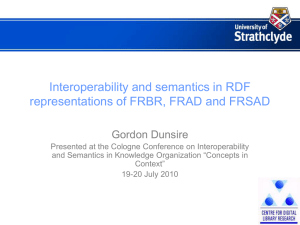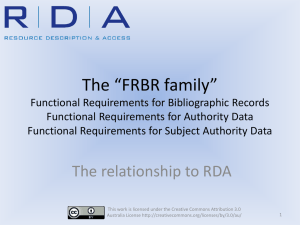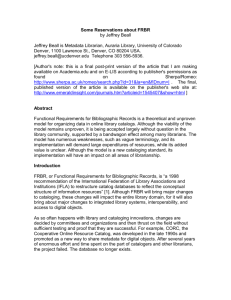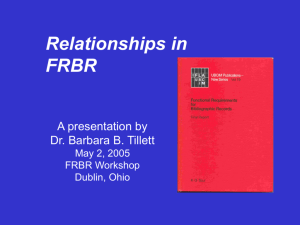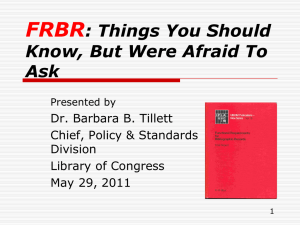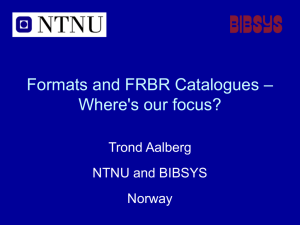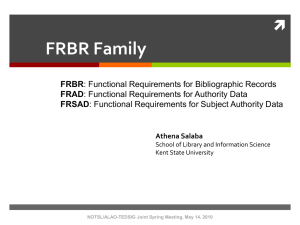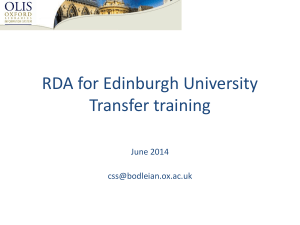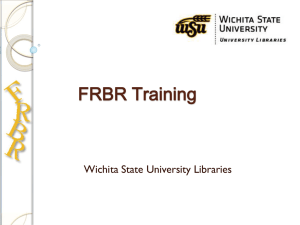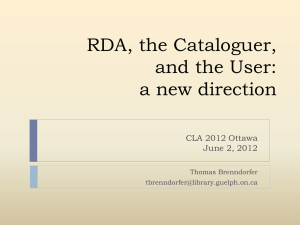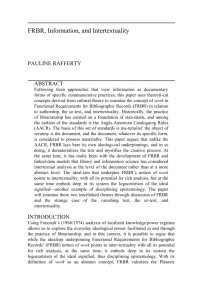FRBR & Semantic Web: Linked Data Presentation
advertisement
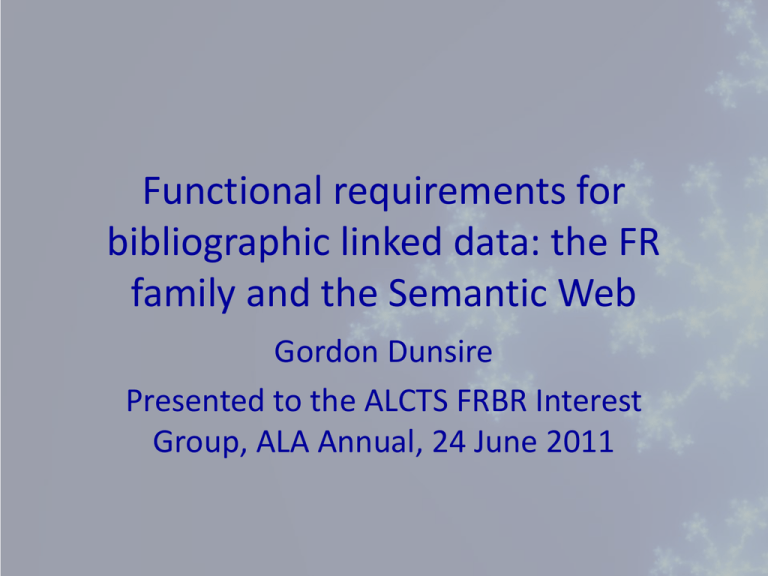
Functional requirements for bibliographic linked data: the FR family and the Semantic Web Gordon Dunsire Presented to the ALCTS FRBR Interest Group, ALA Annual, 24 June 2011 Overview Background Resource Description Framework Representing Functional Requirements for the Semantic Web Some issues Legacy catalogue records FRAD FRBR Does not cover “authorities” Does not cover subjects FRSAD FR Consolidated model Semantic recapitulate 1998Web versions 2009 2010 this sequence: 2012? * * * * Earlier models in use before later models published Later models re-use elements from earlier models Reflects semantic development over time Provides learning curve for FRBR Review Group Background RDA: resource description and access is based on FRBR and FRAD Bibliographic metadata content guidelines DCMI RDA Task Group asked to develop an RDF representation of RDA Following the “London” meeting in April 2007 Stimulated creation of “FRBR namespaces project” To develop RDF representation of FRBR RDF Resource Description Framework Basis of the Semantic Web Metadata expressed as “atomic” statements A simple, single, irreducible statement The creator of this work is R. Shankar Constructed in 3 parts “Triple” RDF triples The creator of this work is R. Shankar Subject of the statement = Subject: This work Nature of the statement = Predicate: has creator Value of the statement = Object: R. Shankar This work – has creator – R. Shankar subject – predicate – object RDF requires the subject and predicate of a triple to have machine-readable identifiers Uniform Resource Identifier (URI) Object of triple can be a URI, or a literal string like a title RDF properties and classes A predicate is called a property Properties link two things A specific work with a specific creator This work <-> R. Shankar A generic type of thing is called a class Works, Persons, Places, etc. Properties can specify which class the subject and object of a triple should belong to Subject “domain”; object “range” Methodology (1) Open Metadata Registry used for basic representation in RDF Same approach as RDA Provides URI assignment; labels, definition, scope note, property range and domain FR family are entity-relationship models Entity => RDF Class E.g. FRBR Work Entity attribute => RDF property E.g. FRBR has-intended-audience Entity-entity relationship => RDF property E.g. FRBR is-realized-through (Work-Expression) Classes Properties FRBR Groups are not (super-)classes [FRBR Review Group] Group 1 entities are not classes [some ontologists] 3.2.5 Person The fifth entity defined in the model is person: an individual. The entity defined as person encompasses individuals that are deceased as well as those that are living. Entity => Class 4.4.12 Capture mode Capture mode is the means used to record notation, sound, or images in the production of a manifestation (e.g., analogue, acoustic, electric, digital, optical etc.). Attribute => Property Label Definition Scope note Label Definition Scope note Verbalised label URI URI for Manifestation Spanish translation of label - URI remains the same Methodology (2) Terminology of labels, definitions and scope notes based as closely as possible on source documentation E.g. Property label = “has” + attribute name Classes and properties declared for prior model(s) reused in current model E.g. FRAD re-uses URIs from FRBR namespace E.g. FRBR Expression; FRBR has-key No re-use of RDF resources from external community namespaces such as Dublin Core Terms Equivalences likely to be established later Methodology (3) FR attribute properties have domain but no range Required by the model for extensibility E.g. FRBR has-key (domain = Work) Relationship properties have domain and range E.g. FRBR is-realized-through (domain = Work; range = Expression) General, non-technical issues Consistency within documentation Written for human consumption; evidence of variable phrasing to make it more readable E.g. “prior”, “preceding”, “first” Consistency of labels of RDF resources E.g. “has a reproduction” (regular) vs “has reproduction” (irregular) Documentation refers to sub-types of entity E.g. “musical work”, “serial” First pass: sub-type => sub-class But wrong due to semantic overlap Opaque URIs http://iflastandards.info/ns/fr/frbr/frbrer/P1001 frbrer:P1001 Not http://iflastandards.info/ns/fr/frbr/frbrer/Work IFLA operates in a multilingual environment Anglophone bias avoided Labels, etc. in English (@en), but no problem in accommodating translations Allows subsequent changes to alternative and preferred labels without causing confusion URI must not change! Linking the FR models Relationships between separate FR model classes and properties are declared with RDF equivalence and hierarchical properties E.g. owl:sameAs, rdfs:subClassOf E.g. FRAD class Corporate Body seems to be a sub-class of FRBR Corporate Body Will inform the consolidated model Which may also require additional classes and properties RDA issues DCMI RDA Task Group has declared parallel FRBR classes within RDA namespace Could not wait for FRBR RDF resources to be approved JSC to decide whether to substitute FRBR namespace resources, or declare equivalence Conflict with FRBR in RDA implementation scenarios? RDA Manifestation “embodies” Work and Expression; FRBR allows only Expression Legacy catalogue records Domain and range of FR (and RDA) properties inhibit use for creating triples from nonFRBRized catalogue records Need separate URIs for each specific Work, Expression, Manifestation, and Item Solution: equivalent properties with no domain or range Need just a URI for the specific resource described RDA has such unbounded properties Thank you gordon@gordondunsire.com FRBR Review Group http://www.ifla.org/en/frbr-rg Open Metadata Registry http://metadataregistry.org/ Library Linked Data Incubator Group http://www.w3c.org/2005/Incubator/lld/ Sponsors ALA Cataloging & Classification Quarterly MARCIVE, Inc.
